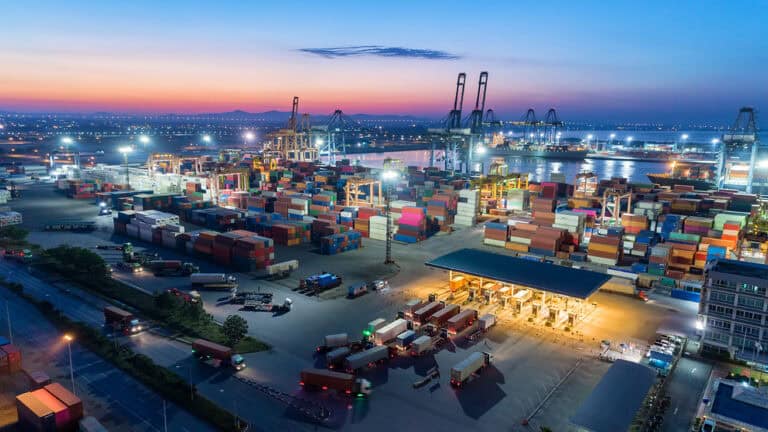
The announcement of new US tariffs on imports from Canada, Mexico, and China has sent ripples through the supply chain world, leaving many leaders scrambling to assess their exposure and develop response strategies. For supply chain leaders, the Trump tariffs are not just policy updates—they represent potential disruptions that can impact costs, shift demand, disrupt supplier networks, and alter production timelines.
As big as this news may be, it’s important to remember that global trade is in constant motion, and the latest tariff activity between the Trump administration, Canada, Mexico, and China underscores the importance of agility in supply chain management. As the political negotiations continue, businesses must take proactive steps to mitigate risks and ensure operational continuity.
So, what do these latest tariff developments mean for your supply chain, and how can companies like yours leverage digital supply chain solutions to mitigate them? First, let’s break down the details of the Trump tariffs in the greater context of global trade.
Understanding the latest tariff moves
Over the weekend (Jan 31 – Feb 2, 2025), the Trump administration announced new tariffs on Canada, Mexico, and China, signaling potential shifts in cross-border trade policies. While the full scope is still unfolding and some elements are sure to change, here are the key takeaways:
- Tariff impositions and rollbacks – Adjustments to US tariffs on key imports and exports could impact manufacturing costs. Depending on how things shake out, companies that rely on raw materials, auto parts, and industrial components from Canada, Mexico, and China may see price fluctuations.
- Trade agreement pressures – While the United States-Mexico-Canada Agreement (USMCA) remains the governing trade framework, continued tariff activity raises concerns about long-term trade stability. Some industries may push for exemptions, while others may face increased compliance requirements.
- Market reaction and business uncertainty – Currency fluctuations, investor sentiment, and shifting trade flows may lead to short-term disruptions in supply chain operations. Businesses that operate just-in-time (JIT) inventory models are at greater risk if lead times increase due to trade policy adjustments.
In short, global supply chains must prepare for volatility—and that means ensuring they have the right tools to anticipate, adapt, and act quickly.
How these new tariffs impact supply chains and how to mitigate them
Let’s get real about what these changes mean for your supply chain management strategy. First, the obvious: tariffs fundamentally alter the cost equation of your supply chain. When you’re looking at a potential 25% increase on certain imported goods, you can either choose to let those costs eat into your profits or pass them on to your consumers. But here’s what many people miss – the impact goes far beyond the immediate cost increase, and has ramifications on sourcing strategies, consumer demand, logistics, and decision-making across the supply chain
1. Higher costs and pricing pressure
When tariffs are introduced or adjusted, supply chain costs change—whether in the form of higher raw material prices, increased transportation expenses, or supplier cost pass-throughs. In light of Trump’s new tariffs, companies that rely on imports from Canada Mexico, and China will need to assess:
- Which materials or products are impacted?
- How will cost increases affect profit margins and pricing strategies?
- Should procurement strategies shift to new suppliers or alternative regions?
How e2open helps: When things can change on a dime, it’s good to have up-to-the-minute information to work with. With real-time cost analysis and supplier insights, businesses can dynamically assess how new tariffs affect their sourcing and adjust procurement plans accordingly.
2. Supplier diversification and sourcing strategies
Relying too heavily on one region or a small group of suppliers leaves businesses vulnerable to trade disputes. Companies must re-evaluate their sourcing strategies and determine:
- Are alternative suppliers available, and at what cost?
- How will shifting suppliers impact quality, delivery times, and customer commitments?
- Can nearshoring or reshoring be a viable solution?
How e2open helps: Having options gives your business the opportunity to adapt to abrupt changes faster than the competition. With a global supplier collaboration platform, businesses gain visibility into alternative suppliers, evaluate costs, and mitigate risks by building a more resilient and flexible supply network.
3. Demand volatility and inventory adjustments
Trade restrictions often lead to demand fluctuations as prices shift and consumer sentiment reacts to market changes. Businesses need to anticipate how demand will be affected by the Trump tariffs and adjust inventory strategies accordingly:
- How will customers respond to price changes?
- Will demand surge before a tariff takes effect, and then decline afterward?
- Should inventory levels be adjusted to buffer against supply disruptions?
How e2open helps: Having insight into how the market will react can give you a head start on responding to volatility. With AI-powered demand sensing, businesses can detect subtle changes in customer behavior and market conditions in real time, allowing for faster, data-driven inventory decisions.
4. Logistics and supply chain coordination
Tariff-related supply chain disruptions often extend beyond suppliers to impact shipping, warehousing, and distribution networks. Businesses should consider:
- Will new tariffs impact transit times due to increased customs processing?
- Do current transportation strategies need adjustments to minimize costs?
- Are alternative trade routes or distribution hubs required as a result of new sourcing locations?
How e2open helps: In a fluctuating market, logistics planning precision isn’t an option, it’s a necessity. With end-to-end supply chain visibility, businesses can proactively manage logistics disruptions and optimize transportation planning to reduce delays and costs.
The path forward: how supply chain leaders can stay agile
Tariffs and trade policy shifts are inevitable, but businesses don’t have to be caught off guard. A digital, connected, and intelligent supply chain is the best defense against uncertainty. By leveraging e2open’s end-to-end supply chain solutions, companies can:
- Plan with confidence – Use AI-driven planning tools to model different tariff scenarios and make proactive adjustments.
- Sense market changes – Gain real-time demand insights to adjust forecasts and avoid inventory misalignment.
- Strengthen supplier relationships – Collaborate with suppliers through a single platform to improve flexibility and reduce risk.
- Optimize costs and logistics – Make data-driven decisions on procurement, transportation, and distribution to minimize disruptions.
Resilience isn’t about reacting to change—it’s about being prepared for it. At e2open, we empower supply chain leaders with the technology and insights needed to navigate today’s evolving trade landscape with confidence.
Adapt now to stay competitive
The latest tariff discussions between the Trump administration, Canada, Mexico, and China reinforce one crucial lesson: Global trade is unpredictable, but supply chain management doesn’t have to be. With the right digital tools and data-driven insights, businesses can transform uncertainty into opportunity.
If you’d like to know more about how your business can navigate trade and tariff uncertainty, visit our Global Trade page. If you’re interested in adopting more resilient supply chain management strategies, contact us today or visit e2open.com.







